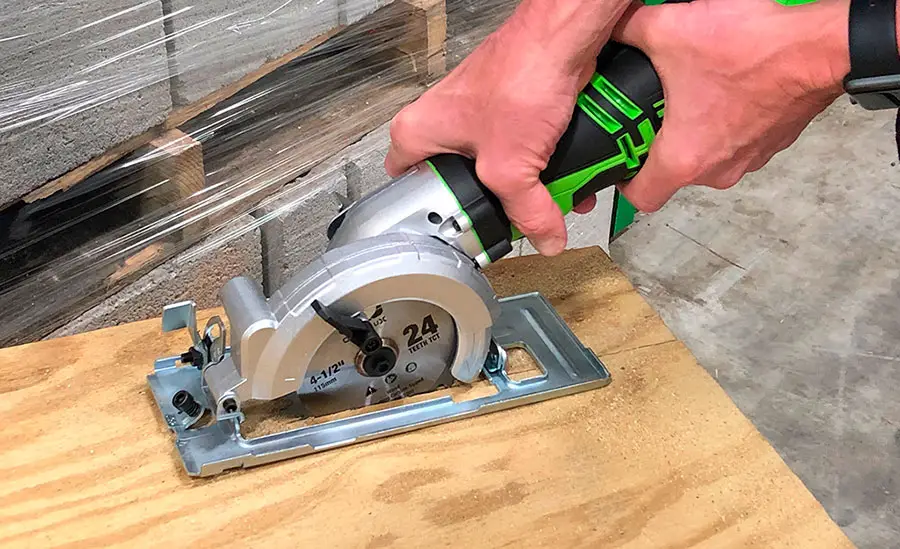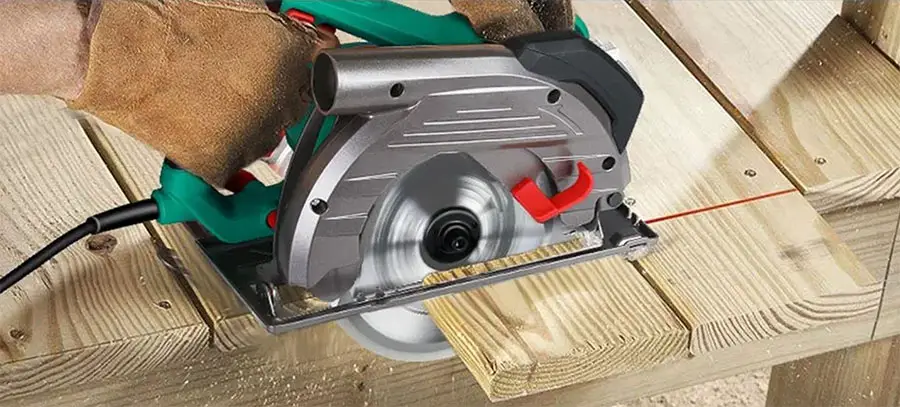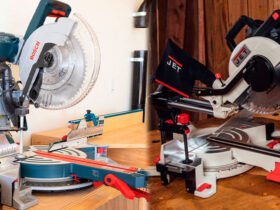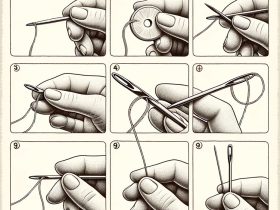When it comes to woodworking and construction projects, selecting the right saw is crucial for achieving accurate and efficient results. The choice between a skill saw vs circular saw often leaves DIY enthusiasts and professionals alike scratching their heads, as both tools appear quite similar at first glance. This article aims to provide a comprehensive comparison of skill saws and circular saws, highlighting their differences and guiding you through the process of choosing the perfect tool for your specific needs. By understanding the unique features and applications of each saw, you’ll be better equipped to make an informed decision and elevate the quality of your work.

What is a Skill Saw?
Definition and purpose
Skill saw, a term often used interchangeably with “circular saw,” actually refers to a specific brand of circular saws called “Skil.” Skil is a popular brand known for producing high-quality power tools, and over time, the name “skill saw” has become synonymous with handheld circular saws in general. These versatile tools are designed for cutting various materials, including wood, metal, and plastic, by utilizing a toothed or abrasive disc or blade.
Common uses and applications
Skill saws are widely used in woodworking, construction, and home improvement projects due to their versatility and ease of use. Some common applications of skill saws include:
- Cross-cutting: Making quick and straight cuts across the grain of the wood.
- Rip-cutting: Cutting along the grain of the wood, usually for resizing larger boards.
- Bevel and miter cutting: Creating angled cuts for molding, trim work, and joining pieces at precise angles.
- Plunge cutting: Starting a cut from the middle of the material, often used for creating openings or cutting out sections.
Key features and components
Skill saws come with various features that enhance their performance, safety, and convenience. Some key components of a skill saw include:
- Blade: The most critical part of the saw, available in different sizes, materials, and tooth configurations to suit specific cutting applications.
- Motor: Provides power to the blade, with varying horsepower and torque depending on the model and intended use.
- Base plate or shoe: A flat surface that rests against the material being cut, ensuring stability and precision during cutting operations.
- Blade guard: A safety feature that covers the blade when not in use, retracting automatically when making a cut to protect the user from potential injuries.
- Bevel and depth adjustment: Allows users to set the angle and depth of the cut, enabling a wide range of cutting applications.
- Ergonomic handles and grips: Designed for user comfort and control, making it easier to maneuver the saw during use.
Overview of Circular Saws

Definition and purpose
A circular saw is a power tool with a round, toothed blade that spins at high speeds to cut through various materials, such as wood, metal, and plastic. Circular saws can be corded or cordless, and they come in different sizes and power levels to suit various applications. The term “circular saw” is often used interchangeably with “skill saw,” but circular saw refers to the entire category of these tools, while “skill saw” specifically denotes Skil-branded circular saws.
Common uses and applications
Circular saws, like skill saws, are versatile tools commonly employed in woodworking, construction, and home improvement projects. Some typical applications for circular saws include:
- Framing: Cutting dimensional lumber to size for framing walls, floors, and roofs.
- Sheet goods: Slicing through plywood, particleboard, or MDF sheets for cabinetry, furniture, and other projects.
- Trim work: Cutting molding, baseboards, and trim to fit precisely in corners and along walls.
- Demolition: Quickly cutting through old materials, such as wood, metal, or PVC pipes, during renovation or demolition projects.
Key features and components
Circular saws come with a range of features that improve performance, safety, and ease of use. Some of the essential components of a circular saw include:
- Blade: Available in various sizes, materials, and tooth configurations to accommodate specific cutting tasks.
- Motor: Powers the blade, with the horsepower and torque varying based on the model and intended use.
- Base plate or shoe: Provides stability and precision by resting against the material being cut during operation.
- Blade guard: A safety feature that shields the blade when not in use, retracting automatically during cuts to protect users from potential injuries.
- Bevel and depth adjustment: Enables users to set the angle and depth of the cut, allowing for diverse cutting applications.
- Dust collection: An optional feature that helps to keep the workspace clean by collecting sawdust and debris during cutting operations.
- Ergonomic handles and grips: Designed to enhance user comfort and control, making the saw easier to maneuver during use.
Skill Saw vs Circular Saw: Comparing
Differences in design
While skill saws and circular saws are often used interchangeably to describe handheld circular saws, the primary distinction lies in the brand. Skill saws are a specific brand of circular saws manufactured by Skil, while the term “circular saw” encompasses a broader category of similar tools produced by various manufacturers. The design differences between skill saws and other circular saws are typically minimal, with the primary variations arising from individual brands and models.
Performance and efficiency
The performance and efficiency of both skill saws and circular saws depend on factors such as motor power, blade type, and user experience. Skill saws, being a well-known brand, generally offer reliable performance and efficiency. However, circular saws from other reputable brands can provide comparable results. Ultimately, the performance of either saw will depend on selecting the right tool for the specific cutting task and ensuring proper maintenance.
Versatility and adaptability
Both skill saws and circular saws are versatile tools capable of handling a wide range of cutting applications. The adaptability of each saw will depend on the specific features, such as bevel and depth adjustment, blade compatibility, and available accessories. While skill saws and other circular saws share many similarities in this regard, individual models may offer unique features that cater to specific needs or preferences.
Safety features and precautions
Safety is a crucial consideration when operating any power tool, including skill saws and circular saws. Both types of saws typically come equipped with essential safety features, such as blade guards, electric brakes, and lock-off switches. The effectiveness of these safety features will depend on the specific model and manufacturer. Users should always follow proper safety precautions, such as wearing protective gear, securing the material being cut, and maintaining a firm grip on the saw during use.
Price and value for money
Skill saws, being a well-established brand, may come with a slightly higher price tag compared to other circular saws. However, the price difference may be justified by the quality, durability, and reliability that the Skil brand offers. When comparing skill saws and circular saws, it’s essential to consider factors such as build quality, performance, features, and warranty in addition to the price. The best value for money will come from a saw that meets your specific needs and preferences while offering reliable performance at a reasonable cost.
Pros and Cons
Skill saws
Advantages:
- Brand recognition: Skill saws are produced by Skil, a reputable brand known for manufacturing high-quality power tools, ensuring reliability and durability.
- Consistent performance: Skill saws are designed to deliver consistent cutting performance across various materials and applications.
- Quality components: Skil often uses high-quality components and materials, resulting in durable and long-lasting tools.
- Wide range of models: Skill saws are available in a variety of models, catering to different needs, skill levels, and budgets.
Disadvantages:
- Price: Skill saws, due to their brand reputation, can be more expensive than other circular saws.
- Brand confusion: The term “skill saw” is often incorrectly used to describe all circular saws, which can lead to confusion when comparing different brands and models.
Circular saws
Advantages:
- Versatility: Circular saws are versatile tools, capable of handling a wide range of cutting applications and materials.
- Multiple brands and options: With numerous manufacturers producing circular saws, consumers have a broader choice in terms of features, price, and quality.
- Availability: Circular saws are widely available at various retailers and online stores, making it easy to find the right saw for your needs.
- Adaptability: Many circular saw models offer adjustable settings and features, such as bevel and depth adjustment, allowing for greater adaptability to different cutting tasks.
Disadvantages:
- Varying quality: With multiple brands and models available, the quality of circular saws can vary significantly, making it essential to research and compare options before purchasing.
- Learning curve: For beginners, using a circular saw may require some practice to achieve accurate and precise cuts.
- Potential safety risks: Circular saws, like all power tools, can pose safety risks if not used correctly and with proper precautions.
Choosing the Right Saw for Your Project
Assessing your project requirements
Before deciding on a skill saw or circular saw, it’s crucial to evaluate the specific needs of your project. Consider the materials you will be cutting, the types of cuts you need to make, and any additional features that may be necessary for your task. By understanding your project requirements, you can narrow down your options and find a saw that meets your needs.
Considering your skill level and experience
Your level of experience with power tools, particularly saws, should also factor into your decision. If you’re a beginner, look for a saw that is easy to use, with intuitive controls and safety features. More experienced users may prioritize additional features, such as bevel and depth adjustments, to accommodate a wider range of cutting applications.
Evaluating budget and brand preferences
Your budget will also play a significant role in choosing the right saw. Skill saws may come at a higher price due to their brand reputation, but they are known for their quality and reliability. However, there are many other reputable brands producing circular saws at various price points. Determine your budget and research different brands and models to find the right balance between cost and quality.
Tips for making an informed decision
- Read reviews: Look for customer reviews and ratings to gain insight into the real-world performance and durability of different saws.
- Consult professionals: If possible, speak with professionals or experienced DIYers who have used the saws you’re considering. Their feedback can be invaluable in helping you make an informed choice.
- Test the saw: If you have the opportunity, try using the saws you’re considering in-store or borrow one from a friend. Hands-on experience can help you determine if the saw is comfortable and easy to use.
- Consider the warranty: A good warranty can provide peace of mind and protection for your investment. Compare the warranties offered by different manufacturers and choose one that best suits your needs.
- Factor in accessories: Some saws may require additional accessories, such as specific blades or a compatible dust collection system. Keep these additional costs in mind when comparing options.
Conclusion
In summary, skill saws and circular saws are versatile power tools used for a wide range of cutting applications. While skill saws refer specifically to circular saws manufactured by the Skil brand, the term “circular saw” encompasses a broader category of similar tools produced by various manufacturers. Despite their similarities, the key differences between these saws lie in their brand reputation, design, and pricing.
Choosing the appropriate saw for your project is crucial to achieving the desired results. It’s essential to consider factors such as project requirements, skill level, and budget when selecting the right saw. Skill saws are known for their quality and reliability, but other circular saws from reputable brands can offer comparable performance at different price points.
Take the time to carefully evaluate your options and gather feedback from reviews, professionals, and hands-on experience. By considering all relevant factors and making an informed decision, you can select the best saw for your needs and ensure the success of your project.
FAQ
To help provide more clarity and guidance, we have compiled a list of frequently asked questions (FAQs) that cover various aspects of these versatile tools.
What is the difference between a worm drive and a sidewinder circular saw?
A worm drive circular saw has its motor positioned behind the blade, which provides increased torque and cutting power. This design also allows for better visibility and control when making long, straight cuts. Sidewinder circular saws, on the other hand, have their motor positioned beside the blade, resulting in a more compact and lightweight design. They are generally faster but provide less torque than worm drive saws, making them suitable for lighter tasks.
Can I use the same blades for both skill saws and other circular saws?
Yes, you can generally use the same blades for both skill saws and other circular saws, as long as they have the same arbor size (the hole in the center of the blade) and are designed for the same cutting applications. It’s crucial to use the appropriate blade for the material you’re cutting and ensure it’s compatible with your saw’s specifications.
How do I properly maintain and clean my circular saw to ensure its longevity?
To maintain and clean your circular saw:
- Unplug the saw or remove the battery before performing any maintenance.
- Regularly clean the saw’s exterior with a soft cloth, removing dust and debris.
- Use a brush or compressed air to remove sawdust from the motor vents, blade guard, and other hard-to-reach areas.
- Inspect the blade for damage, dullness, or warping, and replace or sharpen it as needed.
- Check the saw’s components for wear, such as the brushes, bearings, and cords, and replace them if necessary.
- Apply lubricant to any moving parts, such as the blade guard, as recommended by the manufacturer.
What safety gear should I wear when operating a skill saw or circular saw?
When operating a skill saw or circular saw, it’s important to wear proper safety gear, including:
- Safety glasses or goggles to protect your eyes from flying debris.
- Hearing protection, such as earplugs or earmuffs, to reduce noise exposure.
- A dust mask or respirator to protect your lungs from sawdust and other particles.
- Gloves to protect your hands and provide better grip and control.
- Sturdy, non-slip shoes to prevent slipping while operating the saw.
How do I choose the right blade for my cutting project?
To choose the right blade for your cutting project, consider the following factors:
- Material: Select a blade designed for the specific material you are cutting (e.g., wood, metal, or plastic).
- Teeth per inch (TPI): Blades with higher TPI produce smoother cuts, while lower TPI blades cut faster but with a rougher finish.
- Tooth geometry: Different tooth designs are suited for various cutting applications, such as cross-cutting, rip-cutting, or combination cutting.
- Blade size: Ensure the blade’s diameter is compatible with your saw’s specifications.
- Blade material and coating: Choose a blade material and coating that offer durability and resistance to heat, friction, and wear.
Are there any specific techniques for making precise and accurate cuts with a circular saw?
To make precise and accurate cuts with a circular saw, follow these techniques:
- Use a straight edge, guide rail, or fence to guide your saw and maintain a straight cut line.
- Mark your cutting line with a pencil or chalk, and align the saw’s blade with the line before starting the cut.
- Support the material properly to minimize vibrations and movement during cutting.
- Start the saw and let it reach full speed before making contact with the material.
- Maintain a steady speed and feed rate, allowing the saw to cut without forcing it through the material.
Can I use a circular saw for cutting materials other than wood, such as metal or plastic?
Yes, you can use a circular saw to cut materials other than wood, such as metal or plastic, by using the appropriate blade designed for the specific material. However, ensure that your saw is compatible with these materials and follow the manufacturer’s recommendations for safety precautions and cutting techniques.
What factors should I consider when selecting a corded vs. cordless circular saw?
When selecting a corded vs. cordless circular saw, consider the following factors:
- Power: Corded saws typically offer more power and consistent performance, while cordless saws may have limited power and run time depending on the battery capacity.
- Portability: Cordless saws provide greater freedom of movement and can be used in locations without access to power outlets.
- Weight: Cordless saws can be heavier due to the battery, which may affect user comfort during prolonged use.
- Cost: Cordless saws are often more expensive, especially when considering the cost of batteries and chargers.
- Maintenance: Cordless saws may require more frequent battery replacements and maintenance compared to corded saws.
Evaluate your project requirements, workspace, and personal preferences to determine which type of saw best suits your needs.
References:
- Fine Homebuilding. (2021, June 3). Circular Saws: A Tool Primer. Retrieved from https://www.finehomebuilding.com/
- Woodworkers Journal. (2021, February 9). Circular Saw Tips and Techniques. Retrieved from https://www.woodworkersjournal.com/












Leave a Reply